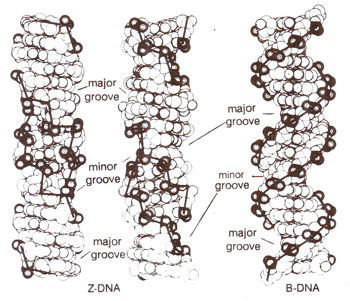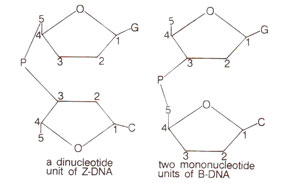Z-DNA, a left handed DNA form
Another form of DNA has been obtained artificially by synthesizing d(C - G)3 molecules which were isolated as crystals. This form of DNA has also been detected in living cells using specific antibodies raised against it. Because this form of DNA follows a zig-zag course, it has been called Z-DNA. It resembles the B form in may respects and differs from it in many other respects (Table 25.2). The differences and similarities have been described below :
Resemblances between Z-DNA and B-DNA


 Differences between Z-DNA and B-DNA
Differences between Z-DNA and B-DNA
In addition to the above, other differences include (i) differences in glycosidic torsion angle, which is anti in B-DNA and syn in Z-DNA for deoxyguanosine and (ii) differences in sugar pucker which is C2’endo for B-DNA and C3' endo for Z-DNA in deoxyguanosine. The situation is reverse for deoxycytidine. These differences are summarized in Table 25.2.



In vivo existence and role of Z-DNA
A few years ago, it was suggested that Z-DNA may be transient configuration of B-DNA in living cells and may thus play a role in (a) regulation of gene activity as suggested by Alexander Rich and/or in (b) genetic recombination as suggested by William Holloman and Eric Kmiec both of U.S.A. Earlier the role of Z-DNA in regulation of gene activity was suggested, since Z-DNA specific antibodies could bind specifically to interband regions of salivary gland chromosomes and not to active banded regions. This suggested that Z-DNA conformation renders the DNA inactive. These observations were later shown to be an artefact of chromosome fixation. However, sequences capable of forming Z-DNA are believed to play a role in recombination or rearrangement of DNA (e.g. immunoglobulin genes; consult Regulation of Gene Expression 3. A Variety of Mechanisms in Eukaryotes).
Resemblances between Z-DNA and B-DNA
- Both are double helical.
- Two strands of double helix are antiparallel in both DNAs.
- Both forms exhibit A = T and G ≡ C pairing.

Fig. 25.16. Two helices, one showing right handed sense as found in B-DNA and the other showing left handed sense as found in Z-DNA.

Fig. 25.17. Side views of Z-DNA and B-DNA. Two views of Z-DNA are 30° apart. Irregularity of backbone in Z-DNA is shown by heavy lines showing the path of phosphate residues, which is quite regular and smooth in B-DNA (redrawn from Nature, Vol. 282, 1979).

Fig. 25.18. Orientation of adjacent sugar residues in Z-DNA and B-DNA showing opposite orientations in Z-DNA and same orientation in B-DNA. This results in dinucleotide units in Z-DNA as against mononucleotide units in B-DNA.
- Z-DNA has left-handed helical sense as against right handed helical sense of B-DNA (Fig. 25.16).
- Due to a different arrangement of molecules within Z-DNA polymer, phosphate backbone follows- a zig-zag course, while in B-DNA it is regular (Fig. 25.17).
- In Z-DNA, sugar residues have alternating orientation (Fig. 25.18) so that repeating unit is a dinucleotide as against B-DNA where repeating unit is a mononucleotide and the orientation of sugar molecules is not alternating.
- In Z-DNA, one complete helix i.e. a twist through 360°, has twelve base pairs or six repeating dinucleotide units (12 base pairs), while in B-DNA, one complete helix has only ten base pairs or ten repeating units.
- Because twelve base pairs are accommodated in one helix in Z-DNA, as against ten in B-DNA, the angle of twist per repeating unit (dinucleotide) is 60°, as against 36° in B-DNA.
- One complete helix is 45 A in Z-DNA while it is 34 A in B-DNA.
- Since bases get more length to spread out in Z-DNA and since the angle of tilt is 60°, they are closer to the axis and hence the diameter of Z-DNA molecule is 18 A, whereas it is 20 Å in B-DNA.
In addition to the above, other differences include (i) differences in glycosidic torsion angle, which is anti in B-DNA and syn in Z-DNA for deoxyguanosine and (ii) differences in sugar pucker which is C2’endo for B-DNA and C3' endo for Z-DNA in deoxyguanosine. The situation is reverse for deoxycytidine. These differences are summarized in Table 25.2.

Fig. 25.16. Two helices, one showing right handed sense as found in B-DNA and the other showing left handed sense as found in Z-DNA.

Fig. 25.17. Side views of Z-DNA and B-DNA. Two views of Z-DNA are 30° apart. Irregularity of backbone in Z-DNA is shown by heavy lines showing the path of phosphate residues, which is quite regular and smooth in B-DNA (redrawn from Nature, Vol. 282, 1979).

Fig. 25.18. Orientation of adjacent sugar residues in Z-DNA and B-DNA showing opposite orientations in Z-DNA and same orientation in B-DNA. This results in dinucleotide units in Z-DNA as against mononucleotide units in B-DNA.
In vivo existence and role of Z-DNA
A few years ago, it was suggested that Z-DNA may be transient configuration of B-DNA in living cells and may thus play a role in (a) regulation of gene activity as suggested by Alexander Rich and/or in (b) genetic recombination as suggested by William Holloman and Eric Kmiec both of U.S.A. Earlier the role of Z-DNA in regulation of gene activity was suggested, since Z-DNA specific antibodies could bind specifically to interband regions of salivary gland chromosomes and not to active banded regions. This suggested that Z-DNA conformation renders the DNA inactive. These observations were later shown to be an artefact of chromosome fixation. However, sequences capable of forming Z-DNA are believed to play a role in recombination or rearrangement of DNA (e.g. immunoglobulin genes; consult Regulation of Gene Expression 3. A Variety of Mechanisms in Eukaryotes).





